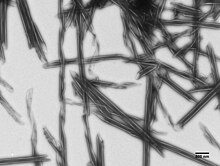R bodies

R bodies (from refractile bodies, also R-bodies) are polymeric protein
Morphology, assembly, and extension
At neutral pH, type 51 R bodies resemble a coil of ribbon approximately 500 nm in diameter and approximately 400 nm deep.[1] Encoded by a single operon containing four open reading frames,[3][4] R bodies are formed from two small structural proteins, RebA and RebB.[5] A third protein, RebC, is required for the covalent assembly of these two structural proteins into higher-molecular weight products, visualized as a ladder on an SDS-PAGE gel.[5]
At low pH, Type 51 R bodies undergo a dramatic structural rearrangement. Much like a
Other types of R bodies from different bacterial species vary in their size, ribbon morphology, and triggers for extension.[1]
Function
When
R bodies are also capable of rupturing E. coli spheroplasts, demonstrating that they can rupture membranes in a foreign context, and they can be engineered to extend at a variety of different pH levels.[9]
